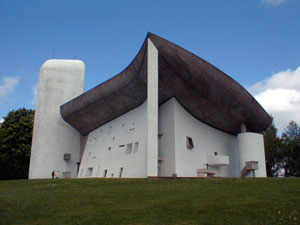
News reports regarding the Catholic church over the last few years have largely been ugly. It was thus a relief to read yesterday of praise for Pope Benedict. Though issues related to his regard for actions of Pope Pius XII in Europe during WWII are yet unresolved, his statements exonerating Jews of complicity in the death of Jesus Christ were very clear.
About the Pope’s remarks Israeli Prime Minister Netanyahu said: “…I commend you for forcefully rejecting in your recent book a false charge that has been the foundation for the hatred of the Jewish people for many centuries…”
Brought to mind an enlightened French cleric about whom I’ve read and with whom I’ve metaphorically crossed paths several times. Father Marie-Alain Couturier fought and was wounded in WWI, became a Dominican priest in 1930, and was vigorously outspoken in refutation of Anti-Semitism in Vichy France*.
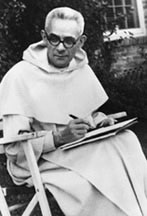
“…I beg of you, remember that you are Christians, that charity tolerates no anti-Semitism, and that even if certain measures seem politically inevitable among those who have been conquered, at least let us maintain the integrity of our hearts…. As for myself, I love only freedom, and as I get older, I couldn’t care less about the rest.”
Another component of Father Couturier’s career (and my initial point of contact) had to do with the integration of art and the sacred. As an artist and founder of the journal “L’Art Sacre”, he sought to invigorate that relationship as had Abbot Suger centuries ago with the development of the first Gothic cathedral. Suger coined the marvelous term “metaphysics of light."
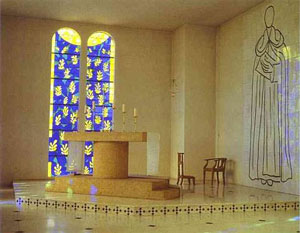
Fr. Couturier worked closely with Matisse on the Chapel de Rosaire in Vence on the Riviera. Matisse was a lapsed Catholic, but Fr Couturier said: “Better a genius without faith than a believer with talent…Trusting in Providence, we told ourselves that a great artist is always a great spiritual being, each in his own manner…”
Similarly, when commissioned to provide a sculpture of the Virgin Mary, Jacques Lipchitz asked the priest: “But, don’t you know I am a Jew? If it does not disturb you, it does not disturb me” was the answer.
Perhaps even more radical was Couturier’s decision to work with twentieth century giant Le Corbusier who “had no place for institutionalized religion within his ideal society”** and sought to demolish historic Paris and replace it with “machines for living” – expressways and high rises.
Interesting, then, that the most well known project of their collaboration was the chapel at Ronchamp (photo way above and interior just below) which was a decidedly uncharacteristic departure for Le Corbusier. About it he said: “People were at first surprised to see me participate in a sacred art. I am not a pagan. Ronchamp is a response to a desire that one occasionally has to extend beyond oneself, and to seek contact with the unknown."
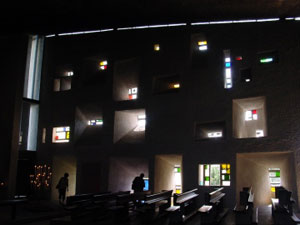
In pre-war Paris Fr. Couturier had met John and Dominique de Menil who were captivated by his vision. He told them that a museum is a place where “you should lose your head." Heirs to the Schlumberger fortune they fled France to the USA settling in Houston where they assembled an incredible collection of art, architecture, and good works.
Italian architect Renzo Piano designed two wonderful museums for them there both incorporating the powerful Texan sun to sublime effect. The Menil holds an eclectic collection of western and African art. The other only the works of Cy Twombly and if you’ve never seen his stuff start there.
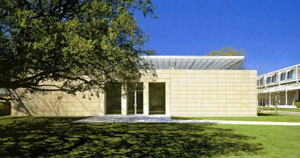
It is the first of Piano’s experimentations with translucent roofing systems. The lid of Twombly filters the natural light through a four part system with tautly drawn Italian sailcloth forming the interior ceiling. The combination of the refined light, the character of the space, and Twombly’s work yields an experience of preternatural transcendence.
Once, upon entering, a woman disrobed to bathe in the light. French philosopher Roland Barthes recalled that he there felt as if in the thrall of a Buddhist awakening. Several years after my visit, allergic reaction shocked into a near death episode, the quality of the ‘white light’ evoked therein seemed identical. No foolin’.
The major work is the 50-foot triptych “Say Goodbye, Catullus, to the Shores of Asia Minor." Catullus was a Roman poet whose brother died and was buried in part of what is now Turkey. As if crossing west across the Mediterranean, the painting leaves color behind on the right, reading left toward pale shades of emptiness.
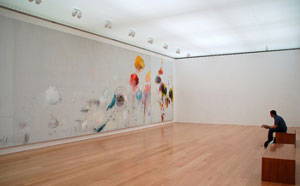
I was bowled over even though I didn’t know the story of the picture at the time of my visit – only upon a bit of research once back home. That knowledge gives special poignancy to memory of the experience because it was on that day one of my two younger brothers underwent surgery for a cancer that claimed his life some months later.
He was an independent thinker, extremely intelligent, creative, sensitive, and spiritual. His challenges to my world view catalyzed significant personal growth. Hmmm… His Tibetan Buddhist friends could engage in interesting speculation related to the fact that Father Couturier died about nine months before Ed was born.
+++++++++++++++++++++
*Father Marie-Alain Couturier, O.P., and the Refutation of Anti-Semitism in Vichy France; Robert Schwartzwald, UMass/Amherst.
**”Almost Religious”; Dennis MacNamara, The Institute for Sacred Architecture, Volume 2.
***Mdm de Menil once offered one of Barnett Newman’s Broken Obelisks to the city of Houston which declined because it was dedicated to the memory of Martin Luther King. It now is in front of the nearby Rothko Chapel. With President Carter, she formed the Carter Menil Human Rights Foundation. The Rothko Chapel gives an award to those struggling against oppression. Another, The Oscar Romero Prize, was named for the murdered El Salvadoran priest.








